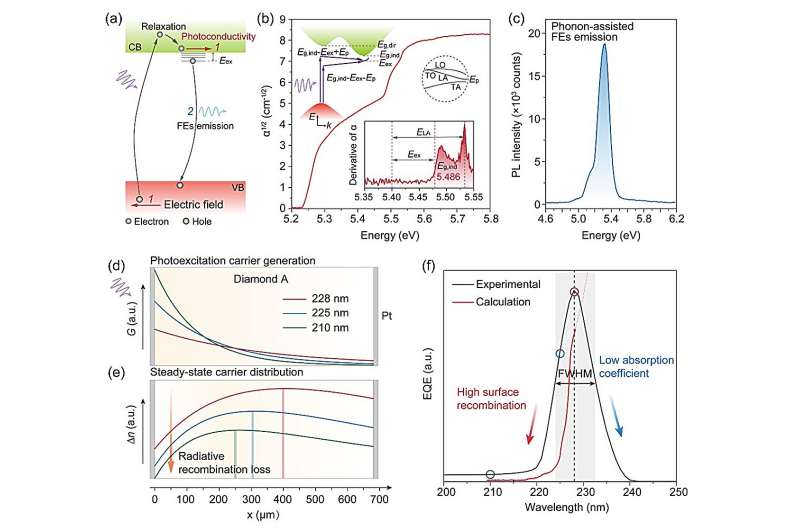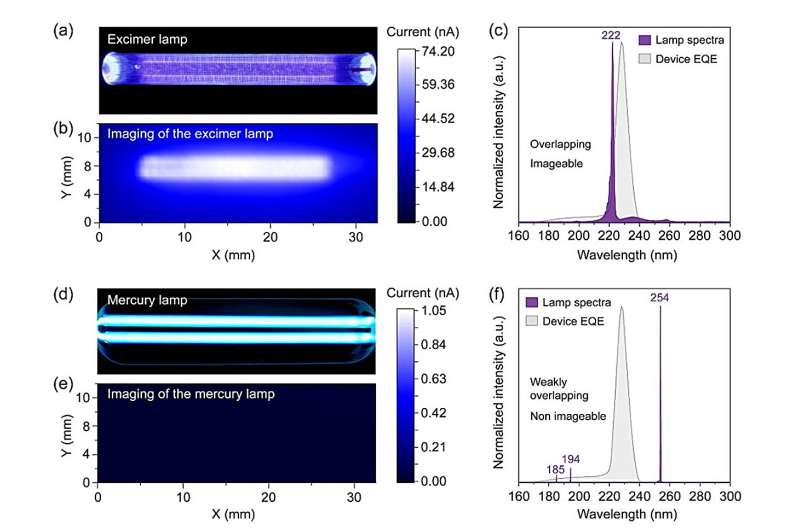This article has been reviewed according to Science X's editorial process and policies. Editors have highlighted the following attributes while ensuring the content's credibility:
fact-checked
proofread
High-quality diamonds empower narrowband deep ultraviolet photodetection

A new publication in Opto-Electronic Science reports how high-quality diamonds empower narrowband deep ultraviolet photodetection.
Compared to traditional broadband detectors, narrowband detectors have a more significant demand for applications in various industrial and cutting-edge scientific research fields due to their precise spectral resolution capabilities.
Typically, there are two methods to achieve narrowband detection at specific wavelengths. The first method involves combining a broadband photodetector with bandpass filters, which is a simple and effective approach but is limited by the availability of filters for certain wavelength bands.
The second method involves designing semiconductor structures to create intrinsic narrowband photodetectors without the need for filters. This approach reduces the complexity of the detection system compared to the first method and ensures good detection/imaging quality but places higher demands on the design of materials and devices.
Intrinsic narrowband photodetectors without filters are gaining popularity in various industrial and scientific research fields, with successful applications in the visible and infrared spectral ranges in recent years. However, there have been few reports on narrowband photodetectors in the deep ultraviolet (DUV) wavelength range, which is highly demanded in fields such as optical communications, environmental monitoring, photolithography, and space exploration.
Diamond, as an ultra-wide bandgap semiconductor, possesses exceptional physical and chemical properties, making it an ideal material for deep ultraviolet photodetection. While increasing sample thickness is a common method for narrowing charge collection in other materials, it is not suitable for diamond.
Most photodetectors based on thick single-crystal diamond exhibit broadband responses due to the high mobility of carriers in diamond and carrier trapping effects. Therefore, another critical parameter for tuning the spectral response is carrier lifetime, which is considered essential for achieving narrowband photodetection. Detailed analysis of the optical and electrical properties of diamond is crucial for achieving precise photomanipulation.
The three different single-crystal diamonds studied in the article are named Diamond A, Diamond B, and Diamond C, with their dislocation densities increasing sequentially. Interestingly, devices based on Diamond A, B, and C exhibit markedly different shapes in their external quantum efficiency (EQE) spectra, with full width at half maximum (FWHM) values of 8 nm, 31 nm, and 52 nm, respectively.
Devices based on Diamond A, characterized by its low dislocation density, display an extremely narrowband response with a peak centered at approximately 228 nm. These devices demonstrate exceptionally low dark current, high detectivity (1013 Jones), and a large linear dynamic range (LDR~118 dB).
Figure 1(a) illustrates the key physical processes that occur during the photodetection in Diamond A, including optical excitation, carrier relaxation, radiative recombination, and photoconductivity under an electric field. Figure 1(b) displays the absorption spectrum of Diamond A, confirming its low density of defect states. By analyzing the differential spectrum in the inset, the bandgap of Diamond A is calculated to be approximately 5.486 eV (with an exciton binding energy of ~80 meV).
Figure 1(c) presents the photoluminescence (PL) spectrum of Diamond A excited by a 193 nm pulse, wherein an exceptionally strong emission of free excitons is observed, indicating that exciton emission is the primary recombination process under optical excitation.

The fabricated narrowband detector can be used for imaging to distinguish different light sources. Figure 2(a) displays an optical photograph of a 222 nm excimer lamp. Figure 2(b) showcases clear imaging of the device with a light source (65×22 pixels). The emission spectrum of the excimer lamp and the EQE of the device are shown in Figure 2(c), with overlapping regions.
It has been proven that 222 nm irradiation is harmless to the human body, making it suitable for surface disinfection and radiation therapy. Research related to the low-pressure mercury lamp is presented in Figure 1(d-e), including optical photographs and corresponding imaging pictures.
The spectral lines of this low-pressure mercury lamp mainly consist of 185 nm, 194 nm, and 254 nm (Figure 2[f]), with the first two generating ozone in the air, posing a health hazard, and the last one causing irreversible damage to human skin and eyes. It is commonly used for indoor germicidal disinfection. Due to only a slight overlap between these spectral lines and EQE, the mercury lamp cannot be imaged. These results indicate that the fabricated narrowband detector can effectively distinguish between the two ultraviolet light sources.
In summary, the reported Diamond A-based photodetector boasts the shortest detection wavelength and the narrowest EQE peak to date. Its potential applications have been demonstrated through preliminary imaging. In the future, the practical performance of this detector can be further improved by fabricating array devices and optimizing the device structure. On the other hand, Diamond A's narrowband response sets it apart from other diamonds, indicating that spectral response testing of diamonds is a feasible method for discerning their quality.
More information: Lemin Jia et al, 8-nm narrowband photodetection in diamonds, Opto-Electronic Science (2023). DOI: 10.29026/oes.2023.230010
Provided by Compuscript Ltd





















